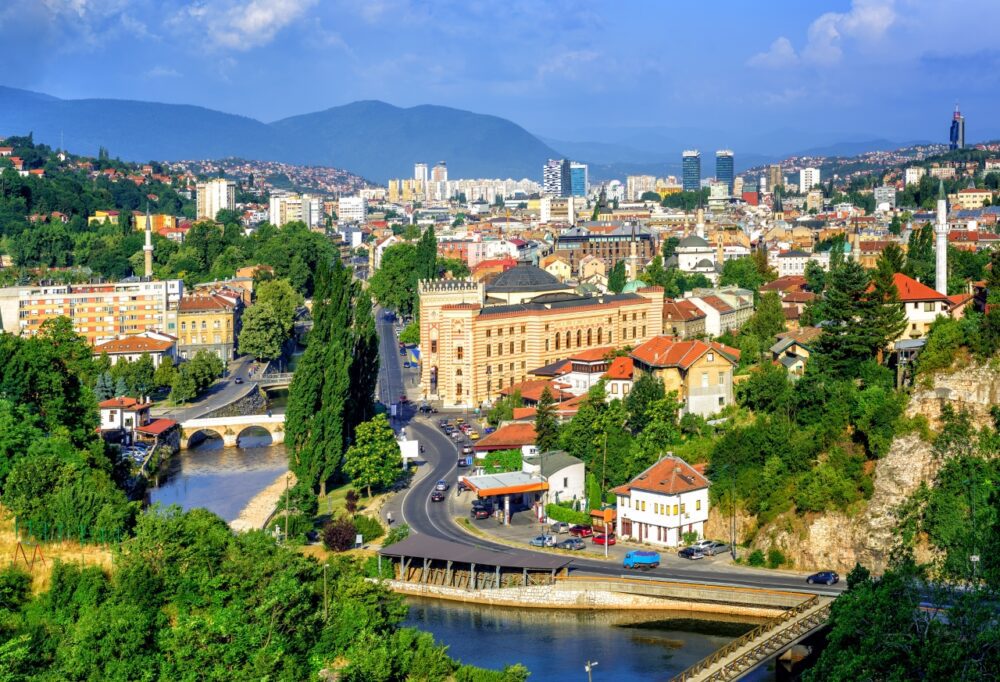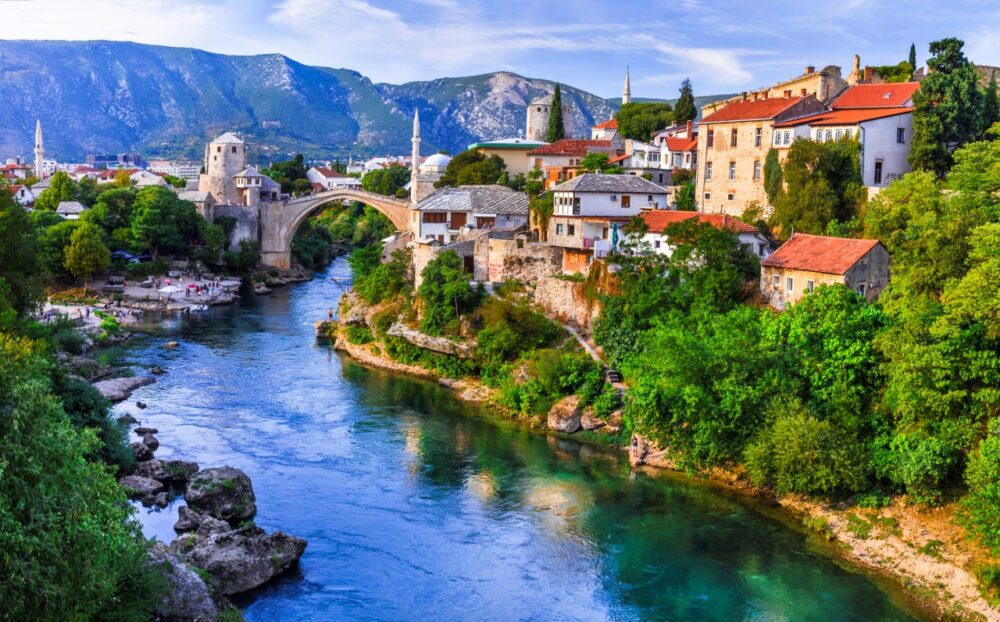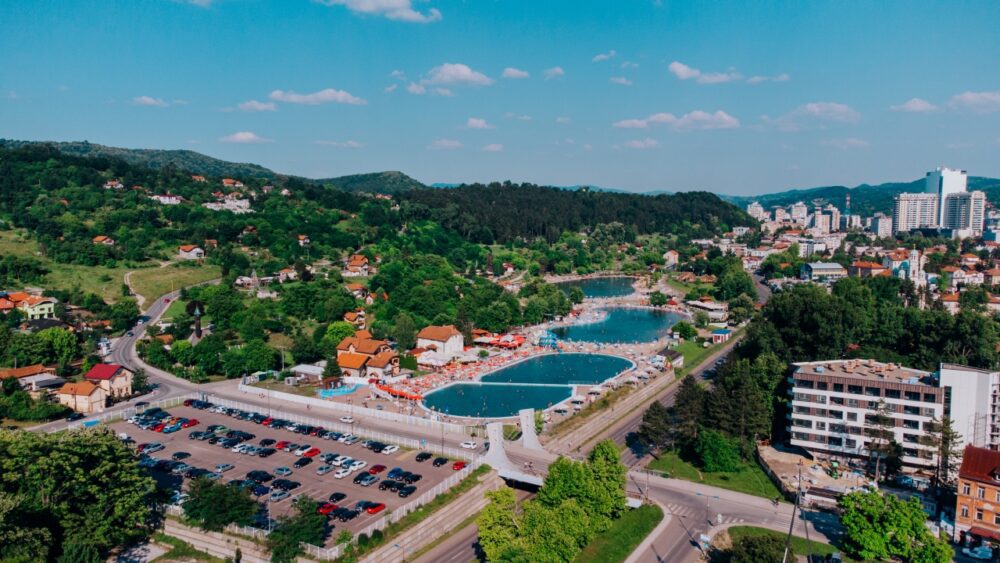
Introduction
Bosnia and Herzegovina is one of Europe’s most captivating and underexplored destinations. Tucked away in the heart of the Balkans, this country is a patchwork of cultures, histories, and stunning natural landscapes. When I first visited, I didn’t quite know what to expect, but Bosnia has a way of getting under your skin. From its vibrant cities and centuries-old mosques to its rugged mountains and tranquil rivers, the country offers a perfect mix of history, adventure, and charm.
Bosnia and Herzegovina is a land that’s still off the beaten path for most tourists, making it an ideal destination if you’re looking for something a little different. Whether you’re wandering the cobbled streets of Sarajevo, diving into the blue waters of Kravica Waterfall, or discovering hidden gems in small towns like Trebinje, you’ll leave with memories of a country that feels both familiar and totally unique.
Table of Contents
Reasons You Should Visit Bosnia and Herzegovina
1. Rich and Complex History
Few countries have a history as fascinating—or as tragic—as Bosnia and Herzegovina. Its story is one of empires, conquests, and cultural crossroads, with a dose of heartbreak from the 1990s war. You can still see the bullet holes and war memorials across the country, but Bosnia’s story is also one of resilience. Its people have rebuilt, and today the country is a place of hope and unity.
Walking through Sarajevo, it’s impossible to ignore the deep layers of history. This city was the site of World War I’s spark—the assassination of Archduke Franz Ferdinand—and more recently, it endured the longest siege in modern warfare. I remember standing in front of Sarajevo’s Latin Bridge, looking at the exact spot where history took a dark turn. Yet Sarajevo is also a city full of life, bustling with cafes, music, and a blend of cultures that feels distinctly Bosnian.
2. Stunning Natural Beauty
Bosnia’s landscapes are nothing short of breathtaking. From the emerald-green rivers and dramatic waterfalls to the wild, forested mountains, the country is a paradise for nature lovers. One of the country’s biggest surprises is Una National Park, a relatively untouched region near the border with Croatia. I spent a day kayaking on the Una River, surrounded by waterfalls and lush forests—it was one of the most peaceful experiences I’ve had in Europe.
If hiking’s your thing, head to Jajce or Blagaj for trails that lead to hidden fortresses and panoramic views. Jajce even has a waterfall right in the middle of the town, where the Pliva River cascades into a gorge. And don’t miss Kravica Waterfall—it’s less crowded than Plitvice in Croatia but every bit as stunning. On a hot day, there’s nothing better than cooling off in the pool beneath the falls.
3. Affordable Travel
Travelling in Bosnia and Herzegovina won’t break the bank, which is a big bonus if you’re looking for an affordable European getaway. Prices for accommodation, food, and activities are much lower than in Western Europe or even some of the Balkan neighbours like Croatia and Slovenia. You can easily get a hearty meal for under €10, and you’ll be hard-pressed to find a hostel or guesthouse that charges more than €30 a night.
I was amazed by how far my money stretched. In Sarajevo, I stayed in a cosy hostel for around €20 a night and had delicious meals of grilled meats and fresh salads for less than €8. If you’re into coffee (and you should be in Bosnia, as it’s a way of life here), a strong Bosnian coffee costs next to nothing—around €1.50—and you’ll find it everywhere.
4. Incredible Food and Coffee Culture
Speaking of food, Bosnian cuisine is one of the country’s most pleasant surprises. It’s a delicious blend of Mediterranean, Ottoman, and Eastern European influences, and you can taste this unique fusion in every bite. If you’re a meat lover, you’ll be in heaven here. Try cevapi, the iconic grilled sausages served with fresh flatbread and onions, or burek, a flaky pastry filled with meat, cheese, or spinach. Both are staples that I found myself ordering again and again.
Vegetarians might find fewer options, but dishes like dolma (stuffed peppers) and ajvar (a roasted red pepper spread) are delicious. And don’t miss the sweets! I’ll never forget my first bite of baklava in Sarajevo—sweet, sticky, and perfectly paired with strong Bosnian coffee. Speaking of coffee, Bosnia’s coffee culture is legendary. In every town, you’ll find cosy cafes where locals spend hours sipping espresso or traditional Bosnian coffee served in a small copper pot.
5. Welcoming and Hospitable Locals
Bosnians are some of the friendliest people I’ve ever met. Hospitality here isn’t just a gesture; it’s part of the culture. Whether I was in a busy café in Sarajevo or a quiet village in Banja Luka, locals went out of their way to make me feel welcome. On more than one occasion, I was invited into someone’s home for coffee or rakija (a strong fruit brandy), despite barely knowing the person. That warmth and generosity stayed with me long after I left.
In smaller towns like Trebinje, locals seem especially excited to see travellers. Even though English isn’t widely spoken outside the main cities, communication was never an issue—everyone I met was keen to help, whether through a few words of broken English or simply gestures and smiles. Don’t be surprised if you leave Bosnia with a few new friends.
Best Places to Visit in Bosnia and Herzegovina
1. Sarajevo

Sarajevo is one of those cities that grabs hold of you and doesn’t let go. It’s a place where East meets West, where you can find mosques, synagogues, and Orthodox churches all within walking distance of each other. The old town, Baščaršija, feels like stepping into another era, with its Ottoman-style market stalls, cobbled streets, and the iconic Sebilj Fountain.
I spent hours wandering Sarajevo’s streets, soaking up the atmosphere. Don’t miss the War Tunnel Museum, where you can learn about the city’s siege during the 1990s. It’s a sobering experience, but also a testament to the resilience of the people who lived through it. For a more uplifting view, take the Sarajevo cable car up to Mount Trebević—the panoramas over the city and surrounding mountains are breathtaking.
2. Mostar

No trip to Bosnia is complete without a visit to Mostar, famous for its stunning Ottoman bridge, Stari Most. It’s one of the country’s most iconic landmarks, and watching daredevils dive into the river below is an unforgettable experience. The bridge was destroyed during the war but rebuilt in 2004, and today it stands as a symbol of resilience and unity.
I recommend heading to the old town in the early morning or late afternoon to avoid the midday crowds. It’s one of those places that’s better enjoyed when it’s quiet, so you can truly appreciate its beauty. Nearby, don’t miss the Koski Mehmed Pasha Mosque, where you can climb the minaret for sweeping views of the bridge and the Neretva River.
3. Blagaj
Just a short drive from Mostar is Blagaj, a serene village famous for the Blagaj Tekke, a Dervish monastery perched at the base of a cliff. It’s one of the most tranquil places I visited in Bosnia. The monastery sits right next to the spring of the Buna River, where the water emerges crystal clear from beneath the rock—perfect for a peaceful boat ride.
Blagaj is the kind of place where you can slow down, enjoy the natural beauty, and take a break from the hustle and bustle. There are a few riverside restaurants nearby where I enjoyed some of the freshest trout I’ve ever had. If you’re looking for a quiet escape, Blagaj is the place to be.
4. Banja Luka

In the northwest of the country, Banja Luka is Bosnia’s second-largest city and the cultural centre of the Republika Srpska region. It’s a city that feels less visited than Sarajevo or Mostar, but no less interesting. I spent a day wandering through its green parks and visiting the Banja Luka Fortress, which offers views over the Vrbas River.
The city has a laid-back vibe and is perfect for those looking to explore Bosnia’s lesser-known spots. The Ferhat Pasha Mosque, a stunning Ottoman-era mosque that was destroyed during the war and rebuilt, is a must-see. And if you’re a fan of rafting, the Vrbas River is the place to go—its fast-flowing waters make for an exhilarating experience.
5. Trebinje
Tucked away in the south, close to the border with Montenegro and Croatia, Trebinje is one of Bosnia’s hidden gems. With its Mediterranean climate and tree-lined streets, it feels more like a coastal town than a Balkan one. The city’s Old Town is a delightful mix of Ottoman and Austro-Hungarian architecture, and I loved wandering through its narrow streets and stopping at cafes for a coffee or a glass of local wine.
For great views, head up to the Hercegovacka Gracanica Monastery. From the hilltop, you can see all the way to the Adriatic Sea on a clear day. Trebinje is also a fantastic base for exploring the nearby wine regions—Bosnia’s wines are surprisingly good, and the locals are more than happy to offer tastings.
6. Neum
Neum is Bosnia’s only coastal town, squeezed between Croatia’s Dalmatian coast. While it doesn’t have the glitz and glamour of Dubrovnik or Split, Neum offers a more laid-back, budget-friendly alternative to its Croatian neighbours. The town is small, but the beaches are lovely, and the water is as clear as you’d expect from the Adriatic Sea.
I spent a relaxing couple of days in Neum, swimming, sunbathing, and indulging in seafood that was as fresh as it gets. If you’re looking for a quiet beach retreat, Neum is a great option—just be aware that it gets busy with locals in the summer.
7. Jajce
Jajce is another of Bosnia’s lesser-known gems, but one that shouldn’t be missed. The town is famous for its stunning waterfall, where the Pliva River tumbles 20 metres into a canyon. It’s a spectacular sight, especially if you catch it during sunset when the light makes the water shimmer.
Jajce’s old town is full of history, with medieval fortifications and churches dating back centuries. Don’t miss the Jajce Fortress for panoramic views over the town and the surrounding countryside. And if you’re feeling adventurous, take a trip out to the Pliva Lakes, where you can rent a kayak or paddleboat for a day on the water.
8. Tuzla

Located in the northeast, Tuzla is one of Bosnia’s quirkiest cities. It’s known for its salt lakes, which are a bit of an oddity in this part of the world. The lakes were created as part of the city’s ancient salt mining industry, and today they’ve been turned into a unique urban beach area. I didn’t expect to find a beach in the middle of a city in Bosnia, but that’s what makes Tuzla so interesting.
Beyond the lakes, Tuzla has a rich cultural scene. It’s home to some of the country’s best festivals, including Panonsko Ljeto (Pannonian Summer), which celebrates music, art, and culture. The city has a youthful energy, thanks to its large student population, and is well worth a visit if you’re passing through the region.
9. Kravica Waterfall
Kravica Waterfall is Bosnia’s answer to Croatia’s famous Plitvice Lakes, but with fewer tourists. The waterfall is set in a stunning forested area near the Croatian border, and the water cascades into a large, natural pool that’s perfect for swimming. I spent a blissful afternoon here, swimming in the cool waters and lounging in the shade.
The area around the falls has picnic spots and a few cafes where you can grab a drink or a snack. It’s the ideal place to escape the heat and relax in nature. And because it’s less touristy than similar spots in neighbouring countries, you’ll have plenty of space to yourself.
10. Una National Park
Una National Park is one of Bosnia’s most pristine natural areas, and if you love the outdoors, this is a must-visit. The park is home to the emerald-green Una River, as well as a series of waterfalls that are straight out of a fairy tale. The park is also a haven for wildlife, with bears, wolves, and lynxes calling it home.
I went on a rafting trip down the Una River, and it was one of the highlights of my time in Bosnia. The river is calm in some sections and wild in others, so it’s great for both beginners and more experienced rafters. If you prefer something less adrenaline-fuelled, there are plenty of hiking trails that offer stunning views of the waterfalls and forests.
Travel Tips for Bosnia and Herzegovina
Getting Around Bosnia and Herzegovina
Public transport in Bosnia and Herzegovina is affordable but can be slow, especially on long-distance routes. Buses are the most common way to get between cities, with regular connections between places like Sarajevo, Mostar, and Banja Luka. Trains are limited, though the scenic train ride from Sarajevo to Mostar is a must. Renting a car is a good option if you want flexibility, especially for exploring rural areas like Blagaj or Una National Park, but be prepared for some narrow, winding roads.
Best Time to Visit Bosnia and Herzegovina
The best time to visit Bosnia and Herzegovina is from May to September, when the weather is warm, and outdoor activities like hiking and sightseeing are at their best. Spring and autumn are ideal for avoiding summer crowds, with pleasant temperatures for exploring cities and national parks. Winter is perfect for skiing in the Dinaric Alps, especially in resorts like Jahorina near Sarajevo, though the cities can be cold and quiet during this season.
Passport and Visa Requirements for Bosnia and Herzegovina
Most visitors, including those from the EU, UK, US, Canada, and Australia, can enter Bosnia and Herzegovina visa-free for up to 90 days. Make sure your passport is valid for at least three months beyond your stay. If you plan to visit neighbouring countries like Croatia or Montenegro, ensure you meet their entry requirements, and carry your passport with you for border crossings.
Currency and Banks in Bosnia and Herzegovina
Bosnia and Herzegovina uses the Bosnian Convertible Mark (BAM), though euros are sometimes accepted in tourist areas. Credit cards are widely accepted in cities, but in smaller towns and rural areas, cash is essential. ATMs are available in major towns like Sarajevo and Mostar, but it’s a good idea to carry enough cash when travelling outside these areas. Currency exchange offices are easy to find, especially in city centres.
Language and Useful Phrases to Know
The official languages are Bosnian, Croatian, and Serbian, but most people in tourist areas speak at least some English, especially the younger generation. Learning a few basic phrases in Bosnian will go a long way—try “Zdravo” (hello), “Hvala” (thank you), and “Da” (yes) or “Ne” (no). Locals are friendly and appreciate visitors making an effort to speak their language.
Budgeting and Costs for Bosnia and Herzegovina
Bosnia and Herzegovina is one of the most affordable countries in Europe. Accommodation, food, and transport are much cheaper than in neighbouring countries like Croatia. You can enjoy a meal at a local restaurant for just a few euros, and public transport is also inexpensive. Entrance fees to museums and historical sites are budget-friendly, making Bosnia and Herzegovina a great destination for travellers looking to explore Europe on a budget.
Conclusion
Bosnia and Herzegovina is a country that defies expectations. Whether it’s the historic streets of Sarajevo, the breathtaking waterfalls of Kravica, or the peaceful rivers of Una National Park, this country has a little bit of everything. It’s a place where East meets West, where ancient history is never far away, and where nature still reigns supreme. And the best part? Bosnia is still relatively off the tourist radar, so you’ll often feel like you have the place to yourself.
If you’re looking for an affordable, culturally rich destination with warm, welcoming locals and stunning landscapes, Bosnia and Herzegovina should be your next adventure. Trust me, it’s a country you won’t soon forget.
